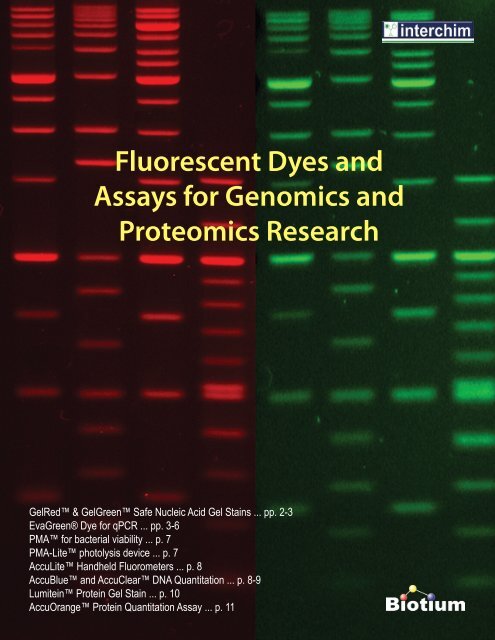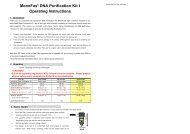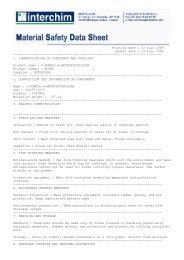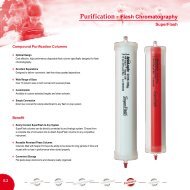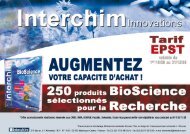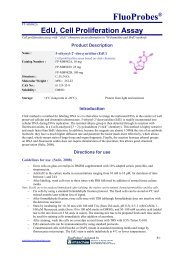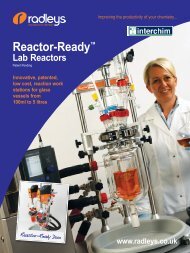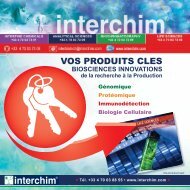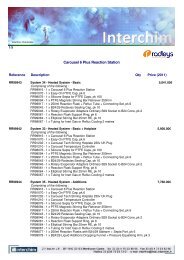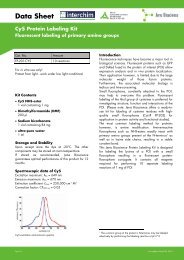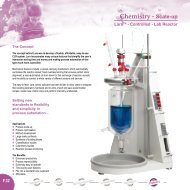Fluorescent Dyes and Assays for Genomics and ... - Interchim
Fluorescent Dyes and Assays for Genomics and ... - Interchim
Fluorescent Dyes and Assays for Genomics and ... - Interchim
- No tags were found...
You also want an ePaper? Increase the reach of your titles
YUMPU automatically turns print PDFs into web optimized ePapers that Google loves.
Safer, ultra-sensitive alternativesto EtBr <strong>and</strong> SYBR® dyesFEATURESSafer than EtBrShown by Ames test <strong>and</strong> other tests to benonmutagenic <strong>and</strong> noncytotoxic.Number of Colonies1000750500250SYBR GreenEtBrGelGreenGelRedEasy disposalPassed environmental safety tests <strong>for</strong> directdisposal down the drain or in regular trash.Ultra-sensitiveMore sensitive than EtBr <strong>and</strong> SYBR ® Safe.Extremely stableStable in solution at room temperature.Simple to useFor precast or post-electrophoresis gel staining.Compatible with st<strong>and</strong>ard instrumentsGelRed replaces EtBr; GelGreen replacesSYBR ® dyes.00 0.1 0.5 1 5 10 25 50Dose (ug/plate)Figure 4. GelRed <strong>and</strong> GelGreen are non-mutagenic. Comparison of mutagenicityamong GelGreen, GelRed, SYBR ® Green I <strong>and</strong> EtBr in +1 frameshift Salmonellaindicator strain TA98 in the presence of S9 fraction. SYBR® Green I became cytotoxic at50 ug/plate. For more in<strong>for</strong>mation, download the GelRed <strong>and</strong> GelGreen Safety Reportat www.biotium.com.Table 1. Ordering In<strong>for</strong>mationDescription Cat. No. Unit Size FeaturesGelRed10,000X in waterGelRed10,000X in DMSO41003-T 25 uL41003 0.5 mL41003-1 10 mL41002 0.5 mLNewer, safer<strong>for</strong>mulation in water(recommended <strong>for</strong>new users)Original <strong>for</strong>mulation inDMSOGelRed3X in water41001 4 LReady to use <strong>for</strong>post-stainingSYBR® Safe GelRed GelGreenGelGreen10,000X in waterGelGreen10,000X in DMSO41005-T 25 uL41005 0.5 mL41005-1 10 mL41004 0.5 mLNewer, safer<strong>for</strong>mulation in water(recommended <strong>for</strong>new users)Original <strong>for</strong>mulation inDMSOReady-To-Use1 kb DNA LadderReady-To-Use100 bp DNA Ladder3102231032150 lanes150 lanesOptimal concentration<strong>for</strong> GelRed/GelGreen precastgels*1 kb DNA Ladder 31021 30 ug100 bp DNA Ladder 31031 30 ugSt<strong>and</strong>-alone laddersFigure 3. GelRed <strong>and</strong> GelGreen gel stains are safer because they cannotpenetrate cell membranes to bind DNA in living cells. HeLa cells were incubatedat 37 o C with 1X SYBR® Safe, GelGreen or GelRed, respectively. Imageswere taken following incubation with dye <strong>for</strong> 30 min. The top row shows phasecontrast images of the field of cells, the bottom row shows green fluorescence <strong>for</strong>SYBR® Safe <strong>and</strong> GelGreen <strong>and</strong> red fluorescence <strong>for</strong> GelRed. SYBR® Saferapidly entered cells <strong>and</strong> stained nuclei. GelRed <strong>and</strong> GelGreen were unableto cross cell membranes, demonstrated by the absence of fluorescence staining.DNA Gel Extraction Kit5X TBE Buffer 41006 4 L31030-50 50 columns Validated <strong>for</strong> usewith GelRed <strong>and</strong>31030-250 250 columns GelGreen*Electrophoresis bufferconcentrate* GelRed <strong>and</strong> GelGreen also are compatible with popular gel extraction kits<strong>and</strong> DNA ladders from other suppliers.<strong>Genomics</strong> <strong>and</strong> Proteomics Products • www.biotium.com • 800-304-5357 3
Superior sensitivity <strong>and</strong> broad dynamic rangeFluorescence120010008006004002000dsDNA-Selective <strong>Assays</strong>dsDNAFigure 2: Triplicate samples of calf thymus dsDNA, mouse liver RNA orsalmon sperm ssDNA were assayed with the AccuBlue High SensitivitydsDNA Quantitation Kit. The AccuBlue High Sensitivity Assay is selective<strong>for</strong> double-str<strong>and</strong>ed DNA over RNA or single-str<strong>and</strong>ed DNA.AccuBlue Broad Range vs. Quant-iT Broad Range (2-4000 ng)RNAssDNA0 20 40 60 80 100DNA/RNA (ng/well)FluorescenceAccuBlue Broad Range (2-2000 ng)70006000500040003000200010000Fluorescence75502500 5 10 15 20DNA (ng/well)R² = 0.99790 500 1000 1500 2000DNA (ng/well)Figure 3: St<strong>and</strong>ard curve of calf thymus DNA assayed using AccuBlue BroadRange Kit <strong>and</strong> read on a microplate reader (Ex/Em 350/460). Inset showsthe lower end of the titration.AccuBlue High Sensitivity (0.2-100 ng)Fluorescence900060003000AccuBlueQuant-iTFluorescence2500200015001000500Fluorescence10075502500 1 2 3 4 5DNA (ng/well)R² = 0.999400 1000 2000 3000 4000DNA (ng/well)Figure 4: Two-fold dilutions of calf thymus DNA were assayed using AccuBlueor Quant-iT Broad Range assay kits. AccuBlue has improved linearity <strong>and</strong>wider dynamic range than the Quant-iT Broad Range.00 20 40 60 80 100DNA (ng/well)Figure 5: St<strong>and</strong>ard curve of calf thymus DNA assayed using the AccuBlueHigh Sensitivity Kit <strong>and</strong> read on a microplate reader (Ex/Em 485/530). Insetshows the lower end of the titration.AccuClear Ultra High Sensitivity 0.03-250 ng)Fluoresence140001200010000800060004000Fluoresence60402000 0.2 0.4 0.6 0.8 1R² = 0.998DNA ng/wellAccuBlueHS DyePicoGreen Dye200000 50 100 150 200 250DNA ng/wellFigure 6: St<strong>and</strong>ard curve of calf thymus DNA assayed using the AccuClearUltra High Sensitivity Kit <strong>and</strong> read on a microplate reader (Ex/Em 460/507).Inset shows the lower end of the titration.Figure 7: The AccuBlue High Sensitivity (HS) reagent <strong>and</strong> PicoGreen were dilutedto working concentrations in HeLa cell cultures <strong>and</strong> incubated <strong>for</strong> 30 minutes.PicoGreen <strong>and</strong> the Quant-iT High Sensitivity reagent (Invitrogen) readily bindnuclear DNA while no nuclear staining is evident with the AccuBlue HS reagent,illustrating its overall safety <strong>and</strong> lower toxicity due to its membrane impermeability.Ordering In<strong>for</strong>mationLinear Range Description Cat. No. Unit SizeBroad Range2-2000 ngHigh Sensitivity0.2-100 ngUltra HighSensitivity0.03-250 ngAccuLite MiniFluorometersAccuBlue Broad Range dsDNA Quantitation Solution, Trial Size 31009-T Each, 200 <strong>Assays</strong>AccuBlue Broad Range dsDNA Quantitation Solution 31009 Each, 1000 <strong>Assays</strong>AccuBlue Broad Range dsDNA Quantitation Kit with 9 DNA st<strong>and</strong>ards 31007 Each, 1000 <strong>Assays</strong>AccuBlue High Sensitivity dsDNA Quantitation Solution, Trial Size 31008-T Each, 200 <strong>Assays</strong>AccuBlue High Sensitivity dsDNA Quantitation Solution 31008 Each, 1000 <strong>Assays</strong>AccuBlue High Sensitivity dsDNA Quantitation Kit with 8 DNA St<strong>and</strong>ards 31006 Each, 1000 <strong>Assays</strong>AccuClear Ultra High Sensitivity dsDNA Quantitation Solution, Trial Size 31027-T Each, 200 <strong>Assays</strong>AccuClear Ultra High Sensitivity dsDNA Quantitation Solution 31027 Each, 1000 <strong>Assays</strong>AccuClear Ultra High Sensitivity dsDNA Quantitation Kit with 7 DNA St<strong>and</strong>ards 31028 Each, 1000 <strong>Assays</strong>AccuClear Ultra High Sensitivity dsDNA Quantitation Kit with 1 DNA St<strong>and</strong>ard 31029 Each, 4000 <strong>Assays</strong>AccuLite 350 Mini Fluorometer E90000 EachAccuLite 470 Mini Fluorometer E90001 Each<strong>Genomics</strong> <strong>and</strong> Proteomics Products • www.biotium.com • 800-304-5357 9
AccuOrange Protein Quantitation KitHighly sensitive, fluorometric protein assayAccuOrange Protein Quantitation Kit is a highly sensitive fluorescence-based assay <strong>for</strong> quantitating purified protein samples in 96-well <strong>for</strong>mat. The detectionrange of the assay is 0.1-15 ug/mL protein. AccuOrange is much more sensitive than traditional protein quantitation assays such as BCA, Brad<strong>for</strong>d <strong>and</strong> Lowry,<strong>and</strong> shows superior linearity <strong>and</strong> reproducibility compared to the NanoOrange® protein quantitation assay (Figure 2). The assay shows minimal variabilitybetween different proteins, <strong>and</strong> has stable fluorescence signal <strong>for</strong> up to 16 hours.AccuOrange is recommended <strong>for</strong> quantitating purified protein or antibody samples. The tolerance of the AccuOrange assay to salts, buffers, detergents, <strong>and</strong>other chemicals is shown in Table 1. The AccuOrange assay has low tolerance <strong>for</strong> non-ionic detergents, <strong>and</strong> is not recommended <strong>for</strong> use with cell lysatescontaining Triton X-100, sodium deoxycholate, CHAPs, or other non-ionic detergents. The assay can tolerate up to 0.01% SDS (final concentration in assay).Table 1. Comparison of AccuOrange with other protein quantitation assays• Ex/Em: 480/598 nmFEATURES• Linear detection range: 0.1-15 ug/mL protein• 200 uL microplate assay• Minimal protein-protein variation• Fluorescence signal stable <strong>for</strong> at least 16 hours• Compatible with reducing agents, amino acids,nucleic acids, <strong>and</strong> imidazole• For use with purified protein or antibody samples• Compatible with AccuLite 470 Mini-Fluorometer(see p. 8)Fluorescence2500200015001000500Fluorescence40020000 0.5 1 1.5BSA (ug/mL)NanoOrangeR² = 0.9453AccuOrangeR² = 0.9981AccuOrangeNanoOrange00 5 10 15BSA (ug/mL)Assay TypeAccuOrangeNanoOrange®Modified LowryBCABrad<strong>for</strong>d(Coomassie)Pierce® 660 nmA 280Detection Range(microplate assay)0.1-15 ug/mL0.1-10 ug/mL1-1500 ug/mL20-2000 ug/mL50-500 ug/mL50-2000 ug/mL50-2000 ug/mLComments• Fluorescence detection (480/598 nm)• Highly linear• Signal stable <strong>for</strong> at least 16 hours• Compatible with reducing agents• Not compatible with detergents• Fluorescence detection (470/570 nm)• Non-linear• Fluorescence stable <strong>for</strong> 6 hours• Compatible with reducing agents• Not compatible with detergents• Absorbance detection (750 nm)• Non-llinear• Not compatible with reducing agents• Not compatible with detergents• Absorbance detection (562 nm)• Highly linear• Signal not stable over time• Not compatible with reducing agents• Compatible with detergents• Absorbance detection (595 nm)• Signal not stable over time• Non-linear• Compatible with reducing agents• Not compatible with detergents• Absorbance detection (660 nm)• Non-linear• Compatible with reducing agents• Compatible with detergents• Absorbance detection (280 nm)• High protein-protein variability• Contaminants such as nucleic acidscan affect resultsNanoOrange is a registered trademark of Molecular Probes Inc.Figure 1. AccuOrange shows better linearity <strong>and</strong> reproducibility compared to NanoOrange®Protein Quantitation assay. BSA titration was per<strong>for</strong>med in triplicate using AccuOrange ProteinQuantitation Kit or NanoOrange Protein Quantitation Kit from Life Technologies according tomanufacturer’s protocol <strong>and</strong> read on a microplate reader at the recommended wavelengths <strong>for</strong>each assay. Inset shows the lower end of the curve. Error bars represent st<strong>and</strong>ard deviation ofthe mean <strong>for</strong> triplicate samples.Ordering In<strong>for</strong>mationDescription Cat. No. SizeAccuOrange Protein Quantitation Kit30071-T 200 assays30071 2000 assays<strong>Genomics</strong> <strong>and</strong> Proteomics Products • www.biotium.com • 800-304-5357 11
Glowing Products <strong>for</strong> Sciencewww.biotium.comBiotium, Inc.3159 Corporate Place,Hayward, CA 94545


